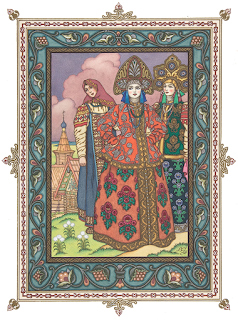 a flea market. These are hollow wooden dolls that come in a set of multiples where the larger doll contains several smaller dolls of diminishing sizes inside. The exterior of these dolls are painted images of animals or more commonly, images of girls wearing traditional Russian outfits. These dolls that are also called matryoshka or stacking dolls, have origins dating back to China some time in the first millennium. It is not until their introduction at the Paris World Exhibition in 1900 did they dramatically increase in prominence. A popularity enduring to this day, making matryoshka dolls a significant part of Russian culture.
a flea market. These are hollow wooden dolls that come in a set of multiples where the larger doll contains several smaller dolls of diminishing sizes inside. The exterior of these dolls are painted images of animals or more commonly, images of girls wearing traditional Russian outfits. These dolls that are also called matryoshka or stacking dolls, have origins dating back to China some time in the first millennium. It is not until their introduction at the Paris World Exhibition in 1900 did they dramatically increase in prominence. A popularity enduring to this day, making matryoshka dolls a significant part of Russian culture.So intrigued was I with these dolls that with further research, discovered the wonderful Russian fairy tales associated with them. One of these tales is Vasilisa the Beautiful. Collected by Alexander Afanasyev and first published between 1855-67. The story begins similarly to that of Cinderella: When Vasilisa is still a young girl, her mother dies and her father remarries a widow with two daughters of her own. Vasilisa is mistreated at home and is forced to do all the work. In hopes that she will be killed, Vasilisa's stepmother instructs her to fetch some fire from Baba Yaga-a fearsome witch who lives deep in the forest.
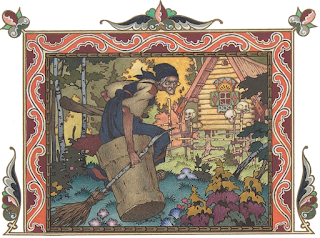
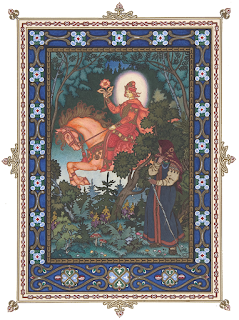 Baba Yaga is unquestionably the most interesting character in the story. This old hag rides a mortar, steers with a pestle and sweeps away her tracks with a broom. Her hut is fenced with the bones of her victims; their skulls whose eye sockets glow an unearthly light in the night. For such a frightening sight, the hut strangely stands on giant chicken feet. To add to Baba Yaga's mystique, the witch also has powerful servants, three riders on horseback: a white rider (dawn of day), a red rider (sun at noon) and a black rider (dark of night). These characters provide ample elements of enchantment, especially when the story is told orally but mainly they are used to describe the passing of time.
Baba Yaga is unquestionably the most interesting character in the story. This old hag rides a mortar, steers with a pestle and sweeps away her tracks with a broom. Her hut is fenced with the bones of her victims; their skulls whose eye sockets glow an unearthly light in the night. For such a frightening sight, the hut strangely stands on giant chicken feet. To add to Baba Yaga's mystique, the witch also has powerful servants, three riders on horseback: a white rider (dawn of day), a red rider (sun at noon) and a black rider (dark of night). These characters provide ample elements of enchantment, especially when the story is told orally but mainly they are used to describe the passing of time.When Vasilisa encounters Baba Yaga, she is given some impossible tasks to complete in order to save herself from being eaten and to receive the fire she requested. To overcome these obstacles, Vasilisa pulls out her magical doll; a final gift from her mother upon her deathbed. With the aid of this doll, Vasilisa completes all of her tasks. In some variations, to be of help, the doll must first be fed. Upon discovering that Vasilisa has accomplished all the incredible tasks, Baba Yaga demanded to know how that was possible to which Vasilisa replies, "My mother's blessing helped me". Baba Yaga immediately kicks Vasilisa out of the hut for she couldn't stand to be near anyone who is blessed. As a reward, fire from one of the skulls is given to Vasilisa. When she arrives home, the skull instructs her to bring it to her stepfamily where upon it burns them to death with its fatal stare. Baba Yaga is an ambiguous character; oftentimes harmful but sometimes helpful like in this instance where she helps Vasilisa escape from her tormentors.
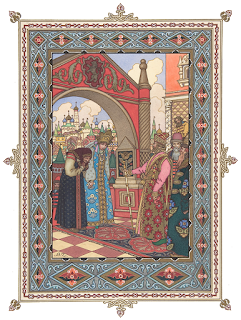 No good fairy tale is complete without a royal wedding! After moving out of her dreadful home, Vasilisa finds shelter in the city with a kind old lady. Here she applies her skill in spinning flax and tailoring. Her work is so magnificent that it impresses the tsar and he demands to meet her. He falls in love with her and they get married. Vasilisa's absent father finally returns from his long journey and everyone lives happily ever after. Bear in mind that in ancient times when this tale was first created, a woman's best qualities was how well she did household chores, how skillful she is in spinning, sewing and how beautiful she looks. Vasilisa is the hero who possesses all of these qualities and more. Typically in newer variations of this tale, Vasilisa's bravery and wit are emphasized over her beauty.
No good fairy tale is complete without a royal wedding! After moving out of her dreadful home, Vasilisa finds shelter in the city with a kind old lady. Here she applies her skill in spinning flax and tailoring. Her work is so magnificent that it impresses the tsar and he demands to meet her. He falls in love with her and they get married. Vasilisa's absent father finally returns from his long journey and everyone lives happily ever after. Bear in mind that in ancient times when this tale was first created, a woman's best qualities was how well she did household chores, how skillful she is in spinning, sewing and how beautiful she looks. Vasilisa is the hero who possesses all of these qualities and more. Typically in newer variations of this tale, Vasilisa's bravery and wit are emphasized over her beauty.There are countless books on Russian fairy tales, below are some favourites:
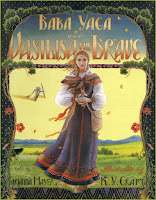 Amazon
AmazonBaba Yaga and Vasilisa the Brave
Retold by Marianna Mayer - Illustrated by Kinuko Y. Craft
HarperCollins 1994
A faithful retelling of Vasilisa and Baba Yaga with beautiful illustrations.
The Magic Nesting Doll
By Jacqueline K.Ogburn - Illustrated by Laurel Long
Dial Books 2000
This cumulative tale combines several Russian stories to create a unique mix of magic, splendor and exquisite illustrations.
The Firebird and Other Russian Fairy Tales
Edited by Jacqueline Onassis - Illustrated by Boris Zvorykin
A Studio Book 1978
Four favourite Russian fairy tales translated into English with artwork reproductions scanned from the originals published in the 1920's. The illustrations above are featured in this book.
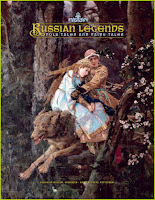 Amazon
AmazonRussian Legends: Folk Tales and Fairy Tales
By David Jackson
nai010 publishers 2008
This catalogue from an exhibit at the Groninger Museum is an excellent resource for Russian fairy tale enthusiast, with superb art reproductions from six renowned Russian artists. Included are summaries of twelve beloved Russian fairy tales.

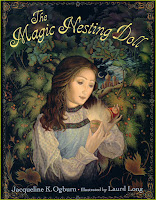
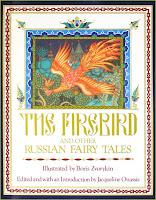
No comments:
Post a Comment